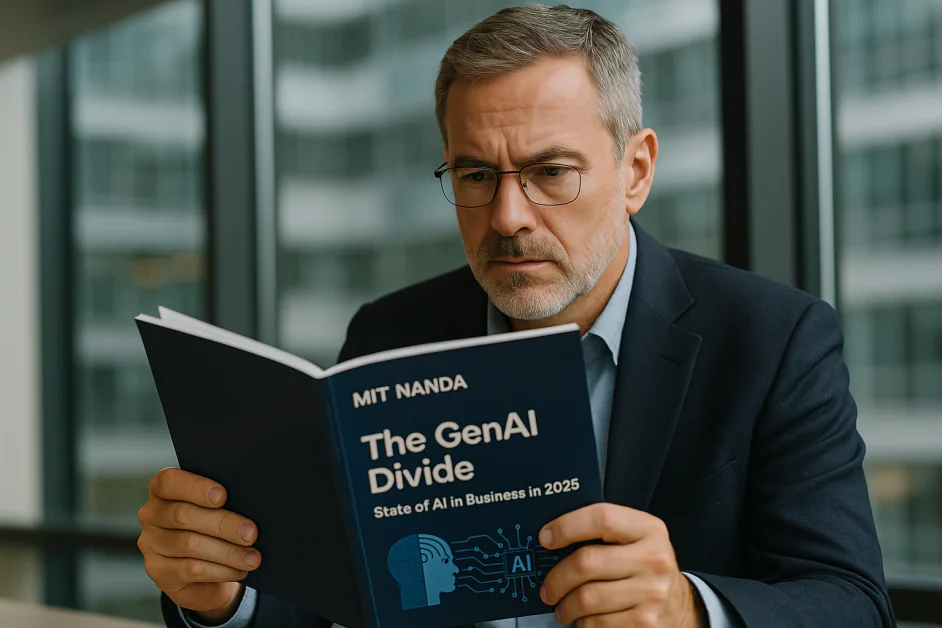Thought Leaders
Looking Into MIT NANDA July 2025 Report: Why 95% AI Pilot Failure Rate Is Not the End

I am a proven optimist, and I keep my mind open for any new technology that comes my way. My latest obsession that is bound to stay for the long-term? AI.
MIT NANDA has recently published its paper called ‘The GenAI Divide. State of AI in Business in 2025’, and I think the paper is really worth the read. It gives a sober outlook on AI and its place in business today. Linkedin feed may seem almost hysterical about how AI came to change everything, yet the report paints a different picture.
First off, what is MIT NANDA?
Networked Agents and Decentralized AI (acronymed to NANDA) is an ambitious research initiative from the MIT Media Lab. The project spans more than 18 leading research institutions from 6 continents and some big names in the tech industry—think Meta, Dell, Microsoft and the like. The goal of NANDA is truly futuristic, if not ground-breaking. The ambition is to build the foundational infrastructure for the Internet of AI agents, i.e. a decentralized network where AI agents discover, verify and collaborate with each other online across organizational boundaries. Basically, NANDA is working on clear rules, protocols, guidelines and frameworks that enable AI agents to interact with other agents on behalf of humans and organizations. The NANDA project is open-source, which means it embraces entrepreneurs, visionaries, technologists and policymakers as full-scale collaborators. (Are you getting Wikipedia vibes?)
The reason I am telling you about this is because MIT NANDA’s report is the icing of the research cake when it comes to AI. The authors are at the very frontier of the AI world, and their findings should be taken seriously (though with a grain of salt).
The paper was in the making since January and was finally published in July 2025. The report is based on a systematic review of 300+ publicly disclosed AI initiatives and interviews of leaders from 52 organizations as well as surveys of 153 senior leaders across four major industry conferences.
5% AI pilot success rate
The report introduces the term ‘The GenAI Divide’ which describes the disruption that happens (or doesn’t happen) to organizations and even industries that are successfully (or unsuccessfully) employing AI. If a business is on ‘the wrong side of the divide’, according to NANDA, the business fails to truly change, evolve and rethink its structure and business operations. To be on the right side of the divide, therefore, means to have a tangible outcome of employing AI—“This investment bias perpetuates the GenAI Divide by directing resources toward visible but often less transformative use cases, while the highest-ROI opportunities in back-office functions remain underfunded”.
The reason the report has gotten so hyped is its key finding. The executive summary states: “Despite $30–40 billion in enterprise investment into GenAI, this report uncovers a surprising result in that 95% of organizations are getting zero return … Just 5% of integrated AI pilots are extracting millions in value, while the vast majority remain stuck with no measurable P&L impact.” Not too promising, right?
The fundamental limitation that prevents organizations from realizing the true value of AI is what the report defines as ‘the learning gap’. Most GenAI systems fundamentally lack the ability to retain feedback, adapt to context, or improve over time.
- Systems don’t learn from feedback. In reality it means a manager feeds it the same data set over and over again, yet no improvement in performance occurs. One mid-market manufacturing manager described repeatedly uploading the same product manual into their AI system to refine fulfillment checklists, yet each iteration copied identical omissions and errors, with no measurable improvement in output quality despite multiple feedback sessions.
- Excessive manual context is required each time. AI tools lack memory between sessions, so every interaction means re-feeding it the past knowledge and past context. Complex workflows, unlike simple one-off tasks, drag on and on, failing to act as a reliable support for ongoing projects. The report cites a corporate legal team that, for every contract draft, must re-enter client preferences, prior negotiation notes, and regulatory constraints into the AI tool—turning what should be an assistive workflow into a time-consuming chore that undermines productivity in complex, multi-stage projects.
- Insufficient customization for some business processes. Instead of getting a responsive tool that adapts to the greater context, the greater context adapts to the tool, forcing users to work around rigid systems. A CIO noted that their vendor-provided risk-analysis AI “felt like a one-size-fits-all box,” forcing teams to reshape their credit-approval workflows to fit the tool’s rigid inputs rather than having the AI adapt to established processes. The mismatch ultimately led to abandoned pilots
My top findings from the NANDA report
1. The Shadow AI Economy Thrives
The report introduces the term ‘shadow AI economy’ to describe how employees use AI at their level as a personal tool, not as an organization-wide approved tool. This sounds familiar to me, actually. A friend of mine from a Chinese automotive brand branch in the CIS shared that she uses ChatGPT to write in-app content (news posts, ads and more). She says that at the HQ-level no AI tool was approved for the general use, so her using AI is her own booster and time-saver that she doesn’t really bring up with her manager.
The report provides very specific figures. While only 40% of companies have purchased official LLM subscriptions, workers from over 90% of surveyed companies reported regular use of personal AI tools for work tasks. This shadow usage often delivers better ROI than formal enterprise initiatives, revealing what actually works when individuals have access to flexible, responsive tools.
2. Investment Allocation Reflects Misplaced Priorities
The report reveals a significant misalignment between AI investment and actual ROI potential. Approximately 50% of GenAI budgets flow to sales and marketing functions, primarily because outcomes can be measured easily and align with board-level KPIs. However, the highest returns often emerge from back-office automation, like BPO elimination saving up to $10M annually, 30% reduction in external creative costs, and $1M saved annually on outsourced risk management. This investment bias perpetuates the GenAI Divide by directing resources toward visible but less transformative use cases.
However, my personal belief is this. From what I remember from my experience at an international banking company that owns retail banks across the world, introducing a tool that digs into the guts of the organization, feeds on its data and (who knows?) leaks insider info out there is a great risk. So I understand why signing up for an AI content factory for easy creatives for Facebook ads is a no-brainer, whereas complex back-end disruptions are not as enthusiastically embraced. Unless it was a command straight from C-level, implementing serious disruptive AI tools into the backbone of the company would have taken at least 12 months.
Luckily, I had a chance to see the inside of an AI automation made for the sales team of a local window manufacturing company. They hired a freelancer from n8n, and he built them an AI-powered call and chat analysis tool. The business now was able to find bottlenecks in their funnel faster, and more pain points came to light as AI helped the business process written and spoken speech. Their satisfaction rate was sky-high, with more data getting processed faster.
3. Internal Builds Lose to External Vendors
To be brutally honest, this finding took me by surprise. Contrary to the common belief that enterprises should build their own AI tools, the research shows that strategic partnerships with external vendors are twice as likely to reach deployment compared to internal development efforts. Who would have thought, right? Well, clearly not me.
Organizations that treat AI vendors like business service providers—demanding deep customization and holding them accountable to operational outcomes rather than model benchmarks—achieve significantly higher success rates and faster time-to-value.
4.Higher Investment Means Higher Disruption? Not really.
Using a composite AI Market Disruption Index, the report reveals that only two industries—Technology and Media & Telecom—show clear signs of structural disruption from GenAI. Seven out of nine major sectors demonstrate significant pilot activity but minimal structural change, with industries like Healthcare, Financial Services, and Energy showing disruption scores below 0.5 on a 5-point scale. This gap between investment visibility and actual transformation exemplifies the GenAI Divide at the industry level.
Why the 95% Failure Rate Is Temporary
Despite seemingly hopeless interim results, there is some light at the end of the tunnel. The report explains that the GenAI Divide is temporary and will be overcome through emerging developments.
NANDA itself is one of the leading contributors to an even more connected AI world. The mechanisms the report cites are Model Context Protocol (or MCP) and Agent-to-Agent (or A2A) as infrastructure foundations for seamless agent interoperability and autonomous coordination across systems.
NANDA’s efforts and these tools are the pathway to exactly what NANDA is after—the Agentic Web, a network of agents capable of autonomous coordination across the internet. Their interaction will be designed to replace static workflows with dynamic self-educating systems.
Does it sound too good to be true or even magic? Well, Microsoft Copilot Studio’s Multi-Agent Orchestration is a closest resemblance to the vision. The system helps build a tree of agents where a main Copilot agent triggers sub-agents that are responsible for specific tasks like scheduling or document generation. Each agent remains within its field of expertise while coordinating with others. To put it in more practical terms, when a user requests “Plan our Q4 product launch,” the orchestrator agent automatically delegates to specialized agents—one handles market research, another manages timeline creation, and a third coordinates with project management tools. The work goes on in sync, yet autonomously.
So, what does the report by NANDA leave us with? The window for crossing the GenAI Divide is narrowing fast as enterprises begin locking in vendor relationships with learning-capable tools that produce disruption and evolve and optimize business operations in the back-end, adding velocity to the very core of organizations. The success lies in buying AI agent systems rather than building them from scratch internally. As agentic learning, remembering and self-sufficient systems become more prevalent, the current 95% failure rate will give way to a new era where AI systems collaborate seamlessly across vendors, domains, and organizational boundaries. That future is the true ROI of current investments.
Alternative Views on AI adoption
The NANDA project did an amazing job at compiling data from multiple sources and surveying leaders from multiple fields. But is it the ultimate mouthpiece to worldwide AI adoption? If you, like me, found The GenAI Divide somewhat depressing, if not discouraging, I’ve found these alternative views on AI adoption to keep my personal AI fire burning.
- Jed Nykolle Harme of IT Brief UK broke down the CIO Playbook 2025 by Lenovo. The study includes feedback from IT leaders across EMEA (Europe, Middle East, and Africa), and its conclusion is far more promising. It turns out the retail industry is leading when it comes to AI satisfaction, where 96% of AI pilot performance either meet or exceed expectations.
- Previously I expressed compassion with gigantic enterprise market players that find AI difficult to implement and are not particularly open to intensive incorporation. Lenovo, however, presents a different picture with Banking, Financial Services and Insurance (BFIS) industries: despite the lowest AI adoption rate of 7%, 33% of those testing AI report that pilots exceeded expectations. The secret to such positive trends is ‘a cautious approach’, as Arabian Business puts it.
- Another reassuring report IBM CEO Study opens with a bold foreword by IBM Vice Chairman Gary Cohn: “As AI adoption accelerates…the ultimate pay-off will only come to CEOs with the courage to embrace risk as opportunity. … When the business environment is uncertain, using AI and your enterprise data to identify where you have leverage is a competitive advantage. At this point, leaders who aren’t leveraging AI and their own data to move forward are making a conscious business decision not to compete.”
- The IBM CEO Survey shows some inspiring facts. For example, AI investment growth is predicted to more than double over the next two years, so nearly 20% of total IT budgets will be allocated to AI—the commitment demonstrates that despite visible and proven challenges, the belief in AI is strong and, most importantly, it is a strategic investment rather than reactive spending.
- Last but not least, 64% of CEOs in the report agree that the risk of falling behind drives investment in new technology well before a clear understanding of its impact is achieved. However, there are no quick decisions. Instead, decisions-makers opt for ‘strategic hedging’. In simple terms, when a competitor launches an AI chat bot for personalized recommendations, you do the same for your website. You may not be sure about revenue increase but you know that if you lag for two more years till that ‘perfect data set’ compiles, you’ll irreversibly lose momentum. So the rule is simple: aggressively copy-cat, then see the outcome.
Conclusion
In conclusion, I’d like to express my personal heart-felt belief in AI. As an entrepreneur, a CMO, a business developer and a former office employee in banking, I see so many ways AI can help optimize budgets, streamline workflows and boost teams. The future is augmented and accelerated. If a business wants to compete, it needs to be AI-fluent. While the findings I presented are controversial, I am convinced that the current AI landscape, with its peaks and hollows, is a natural learning timeframe, repeated again and again with every new technology.












